VFD
Vacuum Fluorescent Display (VFD)
These are miniature low voltage triodes with the anode coated in phosphor rather than a separate target electrode to the Anode as on “Magic Eyes”. Unlike other vacuum devices (Valves aka Tubes or CRT) these are still popular in mass produced consumer equipment such as DVD, Blu-Ray players, HiFi and “Set-boxes”. Unlike the “Magic Eye” the HT is only 12V to 30V, and the grid just below the direct filament cathode to turn a character off. The Grid is driven to full HT to turn “on” the underlying segments, which are usually Anodes. Thus multiplexed display the “grid” switches large areas and the “anode” sub sections under it. The larger multiplexed displays need AC drive on centre tapped feed or else one end of the display is brighter.
Unlike the Magic Eyes the DM160 and IV-15 do not vary in size, but brightness as the grid is varied. All the other types of VFD use On/Off segment and/or digit/character drive rather than continious voltage. Thus the DM160 and IV-15 are like Triode, Vacuum equivalents to LEDs or lamps rather than “Bargraphs” or “Magic Eyes. The Russian IV-15 is often offered as an equivalent of the European DM160 but it’s actually different shape, size and characteristics, though similar.
The first made appearance in 1967 in Japan in desk calculators, perhaps to avoid paying royalty to Burroughs for Nixies. Many older Fujitsu (LD series) and Futaba displays are available on eBay. Since new Futaba, Samsung, Itron and Noritake displays are cheaply available the illustrations concentrate on the NOS Russian parts no longer made. Many NOS Russian parts are from 1980s and 1990s.
Other advantages of VFD is that it’s better in direct sunlight than LCD and LCD stops working if cold. VFD are good for Automotive displays as they are undamaged by Death Valley heat, Siberian Cold, UV of sunlight (which fades LCD colours and filters) and don’t wear out as fast as Magic Eye Tubes.

The true DM160 miniature Triode which is also an VFD annunciator. 1959
Developed as longer life alternative to Neon, with no need for high voltage driver on Logic circuits, before LEDs invented.
(28mm x 5.6mm body inc. tip) 30mA 1.0V Direct filament Cathode, 0.5mA Anode

The Russian IV-15 VFD annunciator
Slightly fatter (24.5mm x 6.5mm body)
In both cases the spiral wire is the anode and is coated with the Phosphor to glow. So both will work as low voltage Triodes. However unlike the DM70 / DM71 there is no variation in length.

Obsolete 1970s Pocket Calculator display. Perhaps 1973.

The two heater filament/Cathodes are visible.
The 1967 desk calculator used a separate tube (triode valve with 7 strip anodes and one dot anode with shared mesh grid) for each digit.
This one has three heater filaments as the cathode:

Futaba 13-BT-67ZTA Much larger. Desk calculator? Good for Testgear
The Grids are clearly visible as a mesh covering each digit. (Datasheets available via P.M.)

This will be a home brew Frequency Counter and DC/AC/RF voltmeter display
Futaba 11-LT-13G Tall, so 5 rather than 3 heater/filament/cathode wires.
You can work out the connections of these with a heater supply and 9V to 12V power, They are all conventional digit/segment multiplexed using about 22V HT when multplexed. (Static tests should be lower voltage). A variety of Octal level shifters or discrete transistors can drive the display from software designed for LEDs. A lower pin count and cheaper option is to use the PT6311 family single chip driver with serial interface.
Modern DVD using PT6311 (also uses it to read all the buttons) and probably a custom Futaba or Noritake display


The PCB will work with any multiplexed VFD
The only major issue is to figure the filament voltage. VFD are still made. Shanghai Zhongying, Futaba , Noritake (now includes Itron) and Samsung (huge selection here) all still supply panels. You may find the data on their site or by email. A similar size panel will usually have the same filament current and voltage.
With longer displays running on only 22V an centre tapped AC drive for filament is needed. For small displays with higher voltage the shading of using DC may not be noticed.
Futaba, Fujitsu and other NOS is available on eBay, but the Russian displays are the most available. Compared to bright backlit LCD they can use less power and can be lower power than LED.
EBAY Searching
Sample Russian and other Vacuum Fluorescent Displays
Simple Annunciator/Indicator (brightness or ON/OFF)
IV-15 VFD (Annunciator)
6.5mm x 24.5mm (similar to TS6997, DM160, CV6094)

Rated (nominal) voltage of filament, 0.65-0,9V constant (fixed) voltage of grid, -0.5V voltage of anode, 50V filament, consumption of current (nominal), 37-47 mA
constant (fixed) current of grid 1.5 uA current of anode 0.85 mA |
|
DM160, Tung Sol 6977 (TS6977), CV6094: VFD, variable brightness (not Russian)
1959 as longer life and easier to interface to transistors than a Neon Bulb (LEDs invented later)
 |
(28mm x 5.6mm body inc. tip) 30mA 1.0V Direct filament Cathode, 0.5mA Anode Blue-green bar lights when control grid is at zero potential. Intended to replace the HV transistor and neon lamp combination. 50VDC at 0.5mA anode in on state; 3VDC on the grid cut-off plate current and light. 20,000 hours life. 4-pin flying leads base. Philips related brands, as Amperex and Mullard The Russian IV-15 is a little fatter and shorter. The KP125 of Kip Electronics is also believed to be similar.
|
Complex Annunciator/Indicator or Bargraphs
IVLM1-1/7 VFD “Bargraph” (seven spots)
|
 Tube size 7.2mm x 78mm (smaller than IV-26) Have been used in sets of five or 10 to make 5×7 or 7 x 10 Dot Matrix panels rated (nominal) voltage of filament: 2.04-2,76V constant (fixed) voltage anodes-segments 10 … 20V pulse voltage anodes-segments < 70V Filament Current: 30… 40mA Anode segment current 10mA
|
| IV-26 VFD “Bargraph” (seven spots) |
|
Tube size: 13 x 115 mm Have been used in sets of five or 10 to make 5×7 or 7 x 10 Dot Matrix panels rated (nominal) voltage of filament: 3.15V constant (fixed) voltage of grid: 25V pulse voltage of grid: 50V filament, consumption of current (nominal): 80mA constant (fixed) current of grid: 15mA |
| ILT1-5 L |
|---|
| 5 squares, many “NC” pins, single grid 100mm long tube |

7 for a 5×7 matrix 14cm x 10cm character?
ILT1-16
Bargraph/Frequency scale? 90mm long

Single Character displays
IV-1 Dot and Minus VFD

IV-4 Starbust VFD

IV-6 VFD

IV-8
10mmx 36mm digit, 7 segment
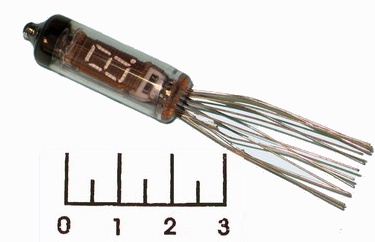
| number of segments in sign |
8 |
| rated (nominal) voltage of filament |
0.7-0,9V
|
| constant (fixed) voltage of grid |
20-30V
|
| pulse voltage of grid |
50V
|
| filament, consumption of current (nominal) |
45-55mA
|
| constant (fixed) current of grid |
5mA |
| Constancy summary current anodes-segments |
2.5mA |
IV- 9 VFD

V -11 , IW -11 VFD 7 segment
![]()

IV-12 VFD


IV-13 VFD

IV17 Starbust VFD
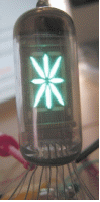
IV22 VFD
Seven segment, 22V HT, 1.2V filament
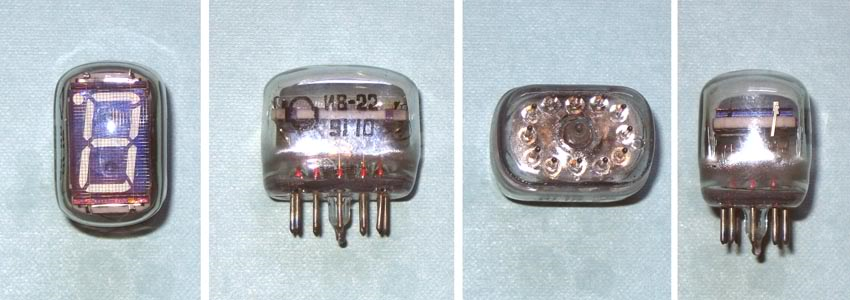
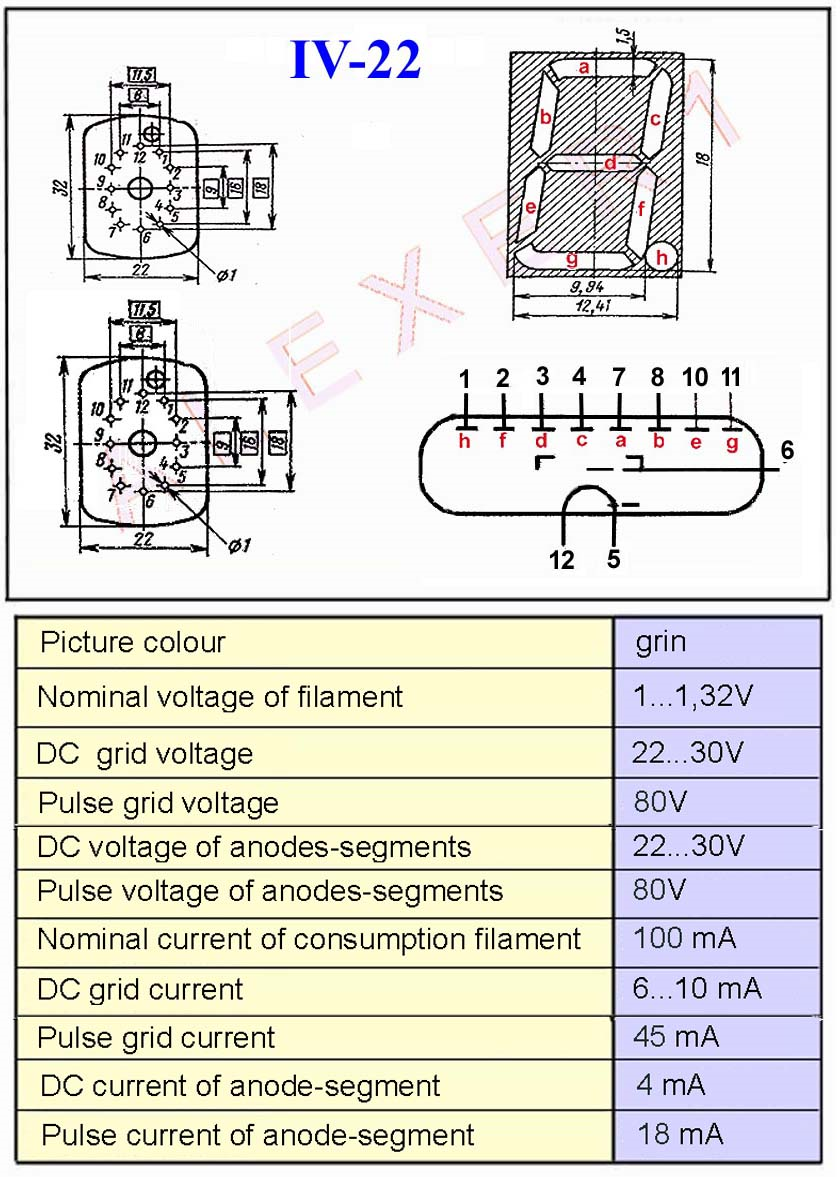
ILC1-1-7 Very large 7 segment VFD
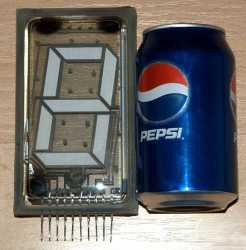
ILC2-1/8 L
1 & Digit
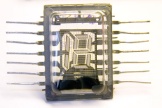
| rated (nominal) voltage of filament |
4.5-5,5
|
| pulse (max) voltage anodes-segments |
36
|
| rated current of grid one sign |
10-16mA
|
| filament, consumption of current (nominal) |
90-110mA
|
| Constancy summary current anodes-segments one sign |
6-10 |
Multiple Digit Displays
IV-18 VFD
8 digit Multiplexed 7 segment,
10.5mm digits, about 115mm long

IV-21 VFD
8 digit Multiplexed 7 segment (Calculator, Frequency display etc)
5.5mm digits? about 60mm long

ICL1-9/8L
8 digit Multiplexed 7 segment about 65mm long
6mm high digits?

Note that the Flat “Planar” Character displays are available as current production from Itron, Noritake, Samsung and Futaba.
These are not much harder to interface than Seven Segment LED displays. Graphics (dot matrix) displays need a controller.
IVL2-7 4 Digit 7 segment VFD
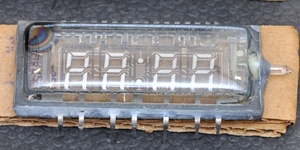
ILC4-16/8L
155mm long envelope, 16 digits and dot annunciators
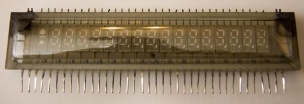
ILC1-8/8
7 digits and symbols
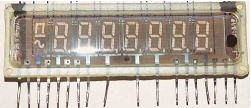
ILC1-9/8L
55mm long envelope, 8 digits plus dots

| rated (nominal) voltage of filament |
4.5-5,5
|
| pulse (max) voltage anodes-segments |
36
|
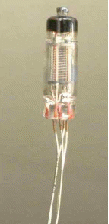
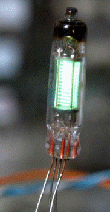
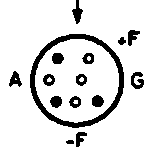 base view
base view
